Fix: Windows Cannot Find One of the Files in this Theme
Some Windows users report randomly receiving the Windows cannot find one of the files in this theme error prompt with no apparent action that might have lead to this scenario. Most affected users report that they never tried to save or modified a theme before the apparition of this error message. Apparently, whatever you end up clicking at the prompt will not have any impact since the error will return after several days. The issue is commonly reported on Windows 10, but it’s also reported on Windows 8 and Windows 7.
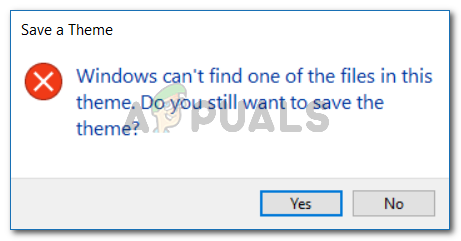
What is causing the Windows cannot find one of the files in this theme error
We investigated the issue by trying to replicate the issue and by looking at various user reports. From what we were able to gather, the issue seems to be quite common when certain scenarios are being met. Here’s a list of potential culprits that might lead to the apparition of this error message:
- SettingSyncHost.exe is glitched – The error message is originating from this executable. If SettingSyncHost.exe is unable to sync your theme across our machine properly, you will get this particular error.
- A custom screensaver is causing the error – Custom screensavers are frequently reported as responsible for this particular error. This is likely applicable if you see the error popping up after a period of inactivity.
- The active theme is glitching – Some users are speculating that this issue will occur if the theme that is currently active is glitching. A lot of affected users have managed to resolve this particular issue changing the active theme and deleting it’s leftover folders.
If you’re struggling to resolve this particular issue, this article will provide you with a quality list of troubleshooting steps. Below you have a list of methods that other users in a similar situation have used to get the issue resolved. For the best results, follow the potential fixes below in the order that they are presented until you find a fix that is effective in solving the prompt for your particular scenario.
Method 1: Disable your custom screensaver
One of the most common causes why this error occurs is because of a custom screensaver that isn’t designed to function with the Windows Themes feature. If you’ve noticed that this error occurs after a period of inactivity, it’s very likely that disabling your screensaver is all you need to do to get the issue resolved.
If you’re fond of screensavers and you discovered that the one you had active was causing the issues, you try reinstalling it or replace it with another one that doesn’t glitch the Windows Theme syncing feature.
Here’s a quick guide on how to disable your screensaver:
- Press Windows key + R to open up a Run dialog box. Then, type “ms-settings:lockscreen” and press Enter to open up the Lock screen tab of the Personalization menu.
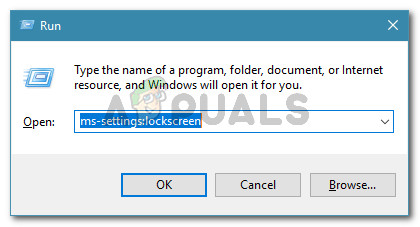
Run dialog: ms-settings:lockscreen - Inside the Lock screen tab, click on Screen saver settings.
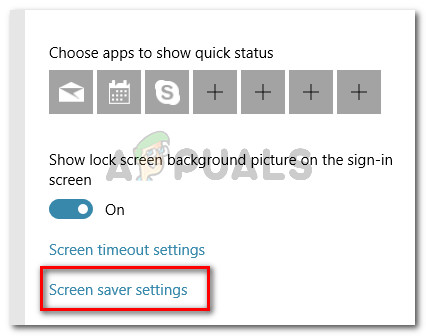
in the Lock screen menu, click on Screen saver settings - In the Screen Saver Settings, access the drop-down menu under Screen saver and set it to none. Then, click Apply to save the changes you’ve just made.
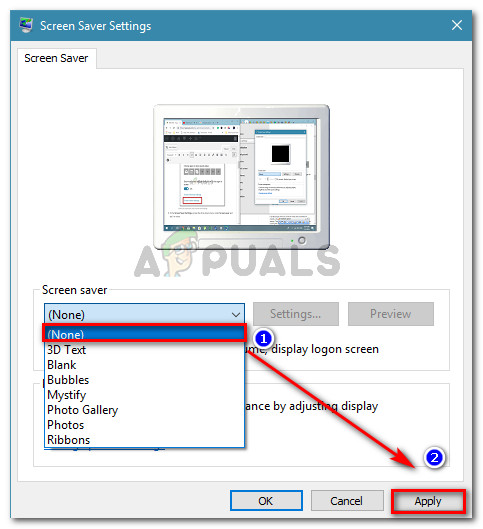
Removing the screen saver - Restart your machine and monitor if the issue has been fixed at the next startup.
If the issue is still not resolved or didn’t have a screen saver enabled on your machine, move down to the next method below.
Method 2: Changing the active theme & deleting leftover files
Another potential fix that some users have used successfully to deal with the Windows cannot find one of the files in this theme error is to change the active theme. The issue might occur because your active theme has become corrupted or it glitched to the point where the syncing part can’t be completed by SettingSyncHost.exe.
A quick way to determine if the active theme is causing the issue is to simply change it with a different one and then delete it along with its folder. If the error is still appearing after performing these steps, you can conclude that the theme is not responsible for the issue. Here’s a quick guide on how to do so:
- Press Windows key + R to open up a Run dialog box. Then, type “ms-settings:themes” and press Enter to open the Themes tab of the Personalization Settings menu.

Run dialog: ms-settings:themes - Once you’re in the Themes section, scroll down to Apply a theme and choose one from the list by clicking on it.

- Press Windows key + R to open up another Run dialog box. Then type “%windir%\Resources\Themes” and press Enter to navigate to the location where the themes are stored.
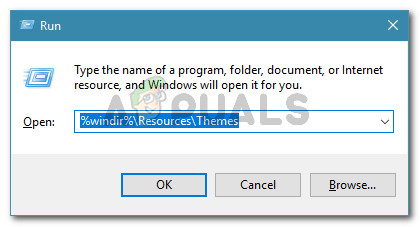
Run dialog: %windir%\Resources\Themes Note: If you’re not on Windows 10, replace the command above with %localappdata%\Microsoft\Windows\Themes or %appdata%\Microsoft\Windows\Themes
- In the themes folder, delete the theme and its corresponding folder. In our case, the theme responsible was Seda, so we deleted both theme variations and the folder storing the rest of its files.
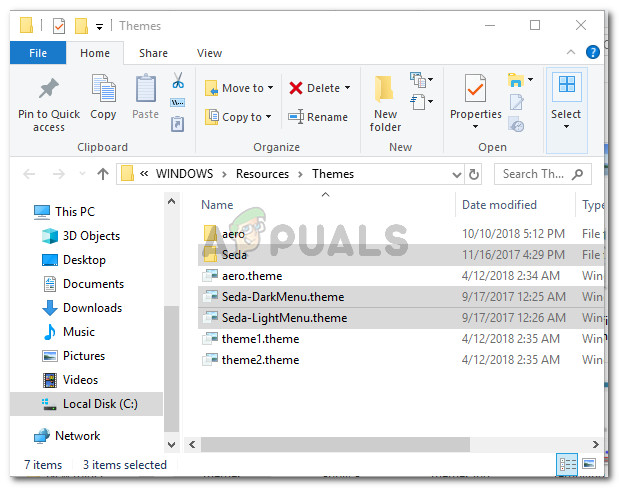
- Now that the theme is changed and the old theme deleted, restart your system and see if the error message returns.
If this method wasn’t effective in resolving the issue, move down to the next method below.
Method 3: Disable theme syncing on your machine
While this method doesn’t actually treat the root cause of the problem nor it allows you to pinpoint the cause of the error, a lot of users have used it to prevent the error from ever resurfacing again.
This method involves modifying some settings used by SettingSyncHost.exe so that theme syncing is prevented. This will most likely stop the messages since the executable will not try to sync your active theme. But keep in mind that the downside of this method is that you’ll lose the ability to sync any themes.
If you decide to use this method and you understand the consequences, follow the steps below to disable the syncing of your theme:
- Press Windows key + R to open up a Run dialog box. Next, type “ms-settings:sync” and press Enter to open the Sync your settings tab of the Accounts Settings page.

Run dialog: ms-settings:sync - Once you get into the Sync your settings menu, scroll down to Individual sync settings and disable the toggle associated with Theme.
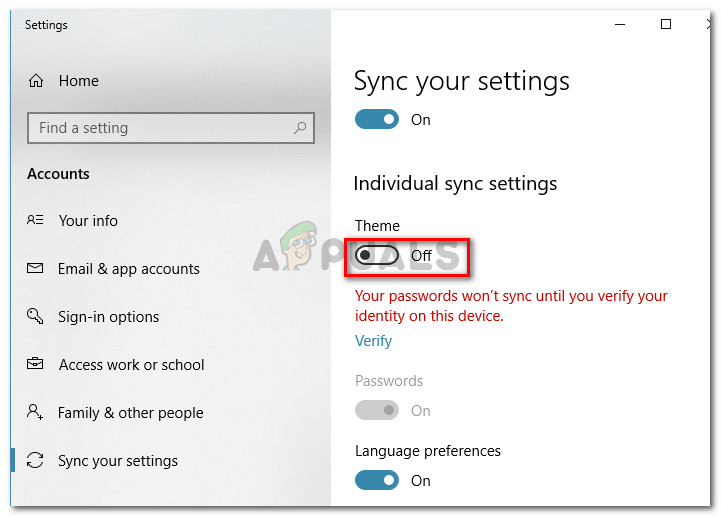
Disabling Theme Syncing on Windows 10 - Once the toggle has been disabled, close the Settings app and restart your computer. At the next startup, monitor the status of your machine and see if you get any additional error messages.
Note: Keep in mind that if you ever need the Theme syncing feature again, you’ll need to reverse engineer the steps above and enable the Theme toggle again.
If this method wasn’t effective or you’re looking for a more focused fix, move down to the next method below.
Method 4: Reinstall the suite of native Windows apps
Some users struggling to resolve the same issue have managed to get it resolved to reinstall the whole suite of System Apps using an elevated PowerShell window. This might seem like an overreach considering the fact that we’re only dealing with a Themes problem, but a lot of users have reported using this successfully to resolve the Windows cannot find one of the files in this theme.
If you decide to follow this method, here’s what you need to do:
- Press Windows key + R to open up a Run dialog box. Then, type “powershell” and press Ctrl + Shift + Enter to open up an elevated Powershell window. When prompted by the UAC (User Account Control) click Yes at the prompt.

Run dialog: powershell, then press Ctrl + Shift + Enter - In the elevated PowerShell window, paste or type the following command and press Enter to trigger the reinstallation of all System Apps (including Themes):
Get-AppXPackage -AllUsers |Where-Object {$_.InstallLocation -like "*SystemApps*"} | Foreach {Add-AppxPackage -DisableDevelopmentMode -Register "$($_.InstallLocation)\AppXManifest.xml"} - Once the command is run and the process is finished, restart your machine and see if the problem has been resolved at the next startup.




